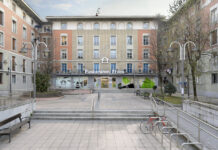The BikePortland website which, as its name indicates, is based in Portland, Ore, has just published an article by Taylor Griggs about her visit to Bilbao during her time in Europe.
By the way, before continuing on with this article, we can’t help but draw our readers’ attention to the huge number of articles that we’ve written about the relationships between this state and the Basques.
But back on topic. The writer wrote this article to analyze the elements that might be of interest to the city of Portland, and gave it the title “What Portland could learn from the ‘Bilbao Effect’”. We would light to slightly modify that, as the term “Bilbao effect” is usually a bad, and overly simplistic, understanding of what happened, and still is, in the Bilbao metro area and throughout the Basque Country.
Not that we’re staying that she’s fallen into that trap, though she does seem to think that the whole of the urban transformation of the city was due to the presence of the Guggenheim Museum, when in fact the museum itself is the consequence of a long-term plan that was started in the 1980s with the Integral Program to Clean Up the Bilbao Estuary. That was followed in the mid-1980s by the start of the construction of the Bilbao Metro. Absolutely nothing about Bilbao can be understood without the cleanup of the river, the metro, and the bay at the mouth of the river that is home to the Port of Bilbao. These three things could be said to be the keys to the urban regenerationof the city, and the Museum is the consequence, rather than the cause, of all of that.
Of course, Taylor Griggs did, quite thankfully, not follow in the footsteps of other journalists, such as Chris Michael and Víctor Núñez Jaime, who came to Bilbao to write what they wanted to, rather than doing any digging into what Bilbao actually is.
As we always say, none of this downplays in any way the importance of the museum for Bilbao. It is the best public investment our country has ever made, at least from the point of view of the budget/global impact ration. And since its opening, its contributions to culture and Basque society go far beyond any economic result; it’s immeasurable.
The author of the article saw that clearly. What matters is how the city takes in people, its residents and its visitors; in what measure is the city “friendly,” designed for people. On reading this article, we recalled what our admired Cesar Pelli, author of the master plan of the Abandoibarra districty and the Iberdrola Tower (which was originally conceived as the Bizkaia Tower) once said: Bilbao has the perfect size for a city: you can live in it on foot, without having to take the car, but it has all the services and cultural offerings of a big city.
If Portland were to take a close look at Bilbao, that’s what they should see: the obsession there is for making a city that is comfortable for people, and it welcoming.
The most important thing Bilbao can offer as a “lesson” for other cities is not the Guggenheim, or the riverwalk, or the subway: it’s the long-term planing, and the ability to define objectives that turn out right. Every city has to find its own goals. What matters is not copying what Bilbao did, but rather the spirit that guided it.
As Taylor Griggs says so well at the end of the article: what should be highlighted is “If the Guggenheim’s titanium panels — and even the Jeff Koons’ ‘Puppy’ installation on the lawn — were to suddenly disappear without a trace, the city would still be worth visiting. More importantly, it would still have resources for the people who actually call this place their home.”
By the way, we’ve read some interesting comments to the article readers have made. We do need to point some things out. What’s most extraordinary about the change in Bilbao is not based on an “event” (like the Olympics or an Expo). It was driven by the political will of the Basque institutions to change the country and adapt it to the new times we found ourselves in. The energy for change, and the money, came out of the pockets of Basque society itself, rather than any “outside agents.”
BikePortland – 26/1/2023 / USA
What Portland could learn from the ‘Bilbao Effect’
The Spanish city of Bilbao is home to about 350,000 residents, is the biggest metropolis in northern Spain’s Basque Country, and its natural beauty and unique history should be attractive to European travelers looking for something a little different. But it’s the armchair urbanists who will really find a treasure trove of riches in Bilbao.
(Follow) (Automatic translation)
Header photo: The Bilbao Guggenheim Museum, designed by Frank Gehry. (Photo: Taylor Griggs:BikePortland)
Last Updated on Jan 31, 2023 by About Basque Country































